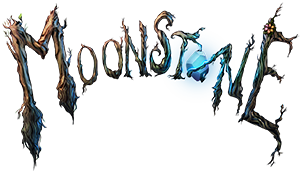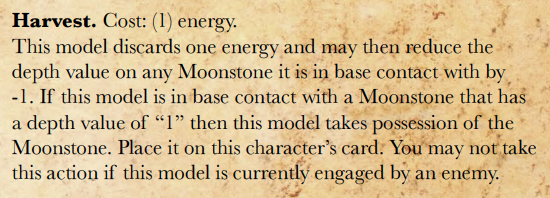Five Tactical Tips For Your First Games
When playing your first game of Moonstone there are a few tips and tricks you can keep in mind to get the best out of your troupe on their first few outings.
This is by no means an exhaustive list of high-end and in-depth tactics and is not specific to a certain troupe or playstyle, but rather a few general pointers for rules unique to moonstone. After your first few games, you will no doubt learn your specific troupes and your playstyle but for the moment let's start with some general tactics!
1. Remember to Harvest Moonstones
However you play the game, you're going to have to harvest moonstones. Games of moonstone are won by whoever has the most moonstones at the end of turn 4 and unlike some other wargames, you don't get anything for kills. If, for example, you reduce your opponent's troupe to one model, but that model has more moonstones collected than your entire troupe, they will win. Moonstones can be harvested at any point in the game. Some troupes may want to harvest a bunch early then play safely and some may want to slay as many enemy models as possible then pick up the moonstones in turn 4.
However, picking up moonstones does bring some disadvantages too. Whilst in possession of moonstones, characters gain 'slow' reducing them to a 2" jog. Therefore picking up moonstones with your big hitters such as Fancyhat in turn 1 could be problematic. This can make it hard for them to get into range of the enemy and start making melee attacks. A good way to get around this is for models like Fancyhat to reduce moonstones to depth 1 on the first turn. Backfield models like healers and long-ranged models can then finish harvesting the moonstones as they don't mind the 2" jog.
2. Use all Your Energy
Energy is used for everything: making melee attacks, taking actions, harvesting moonstones. Energy does not however persist at the end of the turn and you will lose all energy before generating energy for the next turn. Therefore, it is best to try and use all your energy before the end of the turn. This usually isn't too hard though as every model has access to the step action allowing them to move an additional inch at the cost of 1 energy. So a model with no moonstones to harvest, no enemies to attack and no abilities to use can at least move around to get into a better position for the next turn.
However, you often don't want to use all your energy during your activation as saving a little energy can sometimes keep a model alive. In moonstone, models can take 'Reaction steps' after an opponent finishes an action, allowing them to shift an inch in a potentially crucial way. For example, models can move into cover to give a ranged model which has just jogged into position a 2 card penalty. At a closer range, 1" melee models can step into range to ensure they do damage against someone standing outside their melee range with a 2" weapon. Alternatively, they could even step back away and out of range of the attacker preventing them from making melee attacks! In addition, if the end of the turn is approaching and it looks like your model won't be under threat you can still take steps to reposition for the next turn, stepping after any action your opponent may take.
3. Don't Overthink Your Cards
The great thing about the arcane and melee card system in Moonstone is there often isn't: "A right answer" when it comes to cards. Some players will enjoy bluffing at every chance they get and will be good at tricking and reading their opponents. Other players may prefer a risk-averse, cautious and analytical risk/reward based approach. As you play more you will figure out what you enjoy most and what works best for you. For your first few games, the best thing is to not focus too much on the specifics, try a bit of everything and just have fun!
Experimenting with the cards is great, but it can't hurt to have a basic understanding and overview of the cards to start. For example, in melee, you can draw 6 possible cards, with 3 copies of each card composing the deck. Very broadly, the cards are "Defensive" (low guard, high guard & sweeping cut) or "Aggressive" (rising attack, falling swing & thrust). Playing "Defensive" cards, when you want to avoid damage and "Aggressive" when you want to deal damage, is often a good rule of thumb. "Defensive" cards are also usually a good idea when your opponent is outside of your melee range since any damage you would otherwise deal would be reduced to nil. Meanwhile, the arcane deck consists of:
9x 1's (Three of each colour)
6x 2's (Two of each colour)
3x 3's (One of each colour)
3x Catastrophe's
This can be useful to have a rough idea of as if you hold the only green 3 in your resist hand and your opponent says green 3 then you know they're probably bluffing!
4. Activate Healers as Late as Possible
Healing in moonstone is good, very good. It is certainly possible for a good healer to bring a model with 1 wound back up to full health with one activation and some good cards. With this in mind, it can often be a good idea to hold back with your healers and delay their activation to when they can be there most effective. This can be to heal up a badly wounded model about to be slain but is most often at the end of the turn due to how energy interacts with wounds.
As energy generation is determined by the number of uncovered blue pips on the wound bar it is generally better to go into a new turn all healed and healthy. Therefore, a common tactic with healers is to make them your last activation and heal models who will recover energy pips with an additional couple of wounds. Doing this will allow you to maximise your troupes' energy generation for the next turn! On the flip side, if your last activation isn't a healer and is instead a damage orientated model you can strategically target opponents models to hinder their energy generation for the next turn.
5. Have fun!
Finally, the most important thing to do in all your games is to have fun! With such a whimsical setting, very much reflected in most characters rules, games can often result in very amusing scenarios. Personally, one of my early games led to me teleporting a goblin pyromaniac into the middle of my opponents' troupe, blowing him up on purpose, then finishing the survivors with a flatulent pug. It was shortly after this I worked out that I enjoyed building and playing crazy combo troupes! Although there are many other ways to play the game from gun lines to fluffy troupes based on the lore, there is something for every player!





